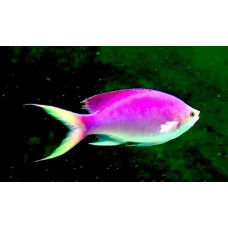Latin name
Mirolabrichthys pascalus
Other name
Mirolabrichthys pascalus
Identification
The Amethyst Anthias has a massive body, a large mouth and spiny gill covers.
Features of fish fins
Dorsal spines (total): 10; Dorsal soft rays (total): 15 - 17; Anal spines: 3; Anal soft rays: 7 - 8.
The dorsal fin of these fish is extended backwards like a pennant. The caudal fin has a very well defined notch and enlarged lobes.
Fish colouring
The colouration of Amethyst Anthias is monochromatic, ranging from pinkish in juveniles and females to dark purple with a lilac tinge in males. Males are also characterised by a large scarlet spot on the enlarged posterior part of the dorsal fin.
Distribution
Widespread in the Pacific: from Bali and the Ryukyu Islands to the Tuamoto Islands, north to southern Japan, south to Australia and New Caledonia.
Habitat
Marine, tropical, reef associated species. Depth range from 0 to 70 metres.
Size
The maximum length of this species is 20 cm.
Behavior
More common on oceanic islands than on continental reefs. They are diurnal. Amethyst anthias swim in large groups around coral ledges and caves on the outer slopes of reefs. They are territorial fish, with males guarding the area and dominating females.
Food and feeding habits
This species feeds on paddlefish and other planktonic crustaceans or crustacean larvae and fish eggs.
Reproduction
This species is characterised by protogynous hermaphroditism: the female can turn into a male, but in harems this is prevented by the dominant male.
Fishing
Amethyst anthias are of no commercial interest in fisheries.
Relationship with a person
Harmless.
| Classification | |
| Phylum | Chordata |
| Class | Actinopterygii |
| Squad | Perciformes |
| Family | Serranidae |
| Genus | Pseudanthias |
| Species | M. pascalus |
| Features | |
| Conservation status | Least Concern |
| Habitat | Pelagic |
| Life span, years | No information |
| Maximum body weight, kg | No information |
| Maximum length, cm | 20 |
| Sailing speed, m/s | No information |
| Threat to people | Not edible |
| Way of eating | Planktonophage |
Amethyst anthias
Tags: amethyst anthias



